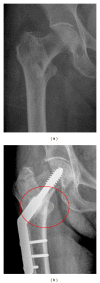Bone marrow stem cells added to a hydroxyapatite scaffold result in better outcomes after surgical treatment of intertrochanteric hip fractures
- PMID: 24955356
- PMCID: PMC4052697
- DOI: 10.1155/2014/451781
Bone marrow stem cells added to a hydroxyapatite scaffold result in better outcomes after surgical treatment of intertrochanteric hip fractures
Abstract
Introduction: Intertrochanteric hip fractures occur in the proximal femur. They are very common in the elderly and are responsible for high rates of morbidity and mortality. The authors hypothesized that adding an autologous bone marrow stem cells concentrate (ABMC) to a hydroxyapatite scaffold and placing it in the fracture site would improve the outcome after surgical fixation of intertrochanteric hip fractures.
Material and methods: 30 patients were randomly selected and divided into 2 groups of 15 patients, to receive either the scaffold enriched with the ABMC (Group A) during the surgical procedure, or fracture fixation alone (Group B).
Results: There was a statistically significant difference in favor of group A at days 30, 60, and 90 for Harris Hip Scores (HHS), at days 30 and 60 for VAS pain scales, for bedridden period and time taken to start partial and total weight bearing (P < 0.05).
Discussion: These results show a significant benefit of adding a bone marrow enriched scaffold to surgical fixation in intertrochanteric hip fractures, which can significantly reduce the associated morbidity and mortality rates.
Conclusion: Bone marrow stem cells added to a hydroxyapatite scaffold result in better outcomes after surgical treatment of intertrochanteric hip fractures.
Figures




References
-
- Abrahamsen B, van Staa T, Ariely R, et al. Excess mortality following hip fracture: a systematic epidemiological review. Osteoporosis International. 2009;15:767–778. - PubMed
-
- Larsson S, Friberg S, Hansson L-I. Trochanteric fractures. Mobility, complications, and mortality in 607 cases treated with the sliding-screw technique. Clinical Orthopaedics and Related Research. 1990;(260):232–241. - PubMed
-
- Parker MJ, Pryor GA, Myles J. 11-Year results in 2,846 patients of the Peterborough Hip Fracture Project: reduced morbidity, mortality and hospital stay. Acta Orthopaedica Scandinavica. 2000;71(1):34–38. - PubMed
-
- Rapp K, Becker C, Lamb SE, Icks A, Klenk J. Hip fractures in institutionalized elderly people: incidence rates and excess mortality. Journal of Bone and Mineral Research. 2008;23(11):1825–1831. - PubMed
-
- Zidén L, Wenestam C-G, Hansson-Scherman M. A life-breaking event: early experiences of the consequences of a hip fracture for elderly people. Clinical Rehabilitation. 2008;22(9):801–811. - PubMed
Publication types
MeSH terms
Substances
LinkOut - more resources
Full Text Sources
Other Literature Sources
Medical

